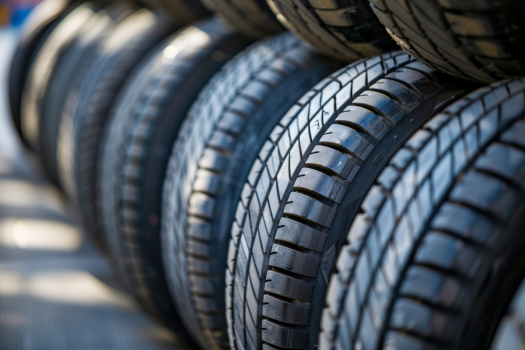Last Updated on April 21, 2024
Unlock the Secrets of Effective Tire Maintenance with Proper Rotation Techniques
Tire maintenance might seem mundane, but there’s an art to it. Among the many techniques, proper tire rotation is a crucial yet often overlooked aspect. Delve with us as we unlock the secrets to effective tire care, ensuring longevity and optimal performance on the road. Discover how mastering the art of tire rotation can elevate your driving experience.
The Unequal Wear of Tires: Why It Happens
Tires don’t wear evenly; front tires carry more than 60% of your vehicle’s total weight and show more wear over time from left turns. Since we tend to make left turns faster than right ones, the disparity in tire-to-road contact results in more stress on the right front tire. Do you see how easy it is to have an unequal tire tread?
The Power of Proper Tire Rotation: Extending Tire Life
The good news is that proper tire rotation equals regular tread patterns, making for a longer and healthier tire life. It can be a DIY or job left to the pros, so long as these best practices are considered.
Deciphering Manufacturer Recommendations: Consulting Your Owner’s Manual
First, Check your owner’s manual for the manufacturer’s recommended tire rotation interval. Research what works best for you, but don’t get distracted! There are several different schools of thought for the best time to rotate tires, and each has its advantages, but following the owner’s manual should always be your primary choice.

Identifying Your Vehicle’s Drive Type
Next up, determine your vehicle’s drive type: Front wheel drive, rear-wheel drive, four-wheel drive, or all-wheel drive. After that, select the tire brand, wheel size, and if you have directional tires (if there’s an arrow on the sidewalls of a given tire, it’s directional).
Front Wheel Drive
Appropriate for front-wheel drive passenger cars, such as minivans and crossovers, the forward cross pattern and X pattern rotations are recommended.
To complete the forward cross, move the front wheels to the rear and the rear wheels to the front and then switch them so that the right rear is on the left front and vice versa.
The X pattern for front-wheel drive is the same as other wheel drive types: switch the right front for the left rear and the left front to the right rear.
Rear, All Wheel, and Four Wheel Drive
Proper tire rotation patterns for the abovementioned wheel drive types consist of the rearward cross and the X pattern—both practical and straightforward. For the rearward cross, the front wheels move to the rear, but the left front switches to the right rear instead of going straight back.
The X pattern is straightforward: rear wheels move to the front and sit on opposing sides.
Both of these rotations are for non-directional tires only.
Directional Tires
You are calling most trucks and SUVs! Use the rear tire rotation pattern if your vehicle has directional tires of the same size. To accomplish this, move the rear wheels to the front and the front wheels to the rear on the same side; do not cross either end.
Tires-Easy has been supplying quality new tires online to United States consumers since 2004. We pride ourselves on having the best selection of quality new tires and an extensive knowledge center to aid our customers in the tire buying process. Our customers can easily find the necessary tires at prices that suit their budget. Check out our blog and knowledge center for more useful tire-buying info at Tires Easy.
Conclusion
Tire maintenance is not just about ensuring a smooth drive; it’s about maximizing the longevity and efficacy of one of the most crucial components of our vehicles. Proper tire rotation, understanding the nuances of drive types, and following manufacturer recommendations extend our tires’ life and enhance our rides’ overall safety and performance.
Recognizing the uneven wear patterns and taking timely measures can make all the difference in our driving experience, ensuring we get the best out of our tires for every mile traveled.
Choosing a trusted partner like Tires-Easy guarantees that your tire needs are met with the best quality and expertise. With years of experience and a vast knowledge reservoir, they simplify the tire buying process, making it efficient and tailored to your needs.
Remember, tires are not just a purchase but an investment in your vehicle’s performance and safety.
Choose wisely, rotate regularly, and drive with confidence.
FAQs
What are the proper tire rotation ways?
The appropriate tire rotation method primarily depends on your vehicle’s drive type: front-wheel drive, rear-wheel drive, all-wheel drive, or four-wheel drive. Generally:
- For front-wheel drive: Move the rear tires to the front in the same position and switch the front tires to the rear, crossing them (right goes to left, left goes to right).
- For rear-wheel drive: Move the front tires to the rear in the same position and switch the rear tires to the front, crossing them.
- For all-wheel/four-wheel drive: A common practice is to move the front right to rear left and front left to raise right, and vice versa.
Always consult your vehicle’s owner’s manual for specific guidance.
How many km for TYRE rotation?
The standard recommendation is to rotate tires every 8,000 to 10,000 kilometers. However, always check your vehicle’s owner’s manual for specific recommendations, as certain vehicles or tire types might have different intervals.
Should tires be rotated clockwise?
Tires aren’t necessarily rotated in a clockwise or counter-clockwise manner. Instead, they are turned based on the vehicle’s drive type and the recommended rotation pattern (e.g., front-to-back, cross pattern). Again, it’s best to consult the owner’s manual or a tire expert for guidance.
Should I rotate my tires every 5,000 or 10,000?
While many experts suggest a tire rotation every 8,000 to 10,000 kilometers, some manufacturers or tire professionals might recommend doing it more frequently, such as every 5,000 kilometers. It’s crucial to balance regular maintenance with the specific needs of your vehicle and driving conditions. Always check your owner’s manual and consider the wear patterns on your tires.









